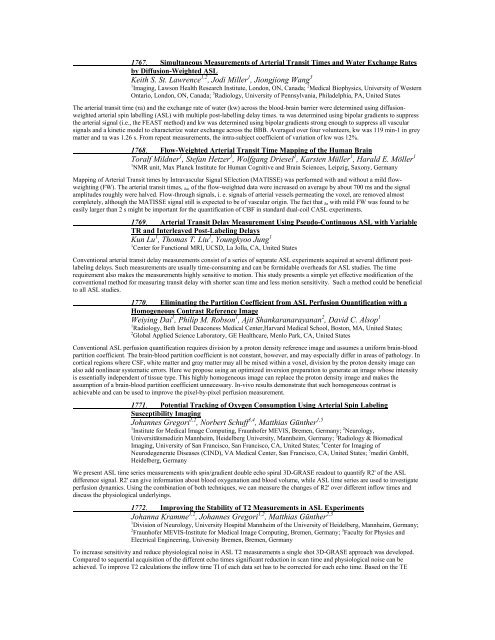Traditional Posters: Diffusion & Perfusion - ismrm
Traditional Posters: Diffusion & Perfusion - ismrm
Traditional Posters: Diffusion & Perfusion - ismrm
You also want an ePaper? Increase the reach of your titles
YUMPU automatically turns print PDFs into web optimized ePapers that Google loves.
1767. Simultaneous Measurements of Arterial Transit Times and Water Exchange Rates<br />
by <strong>Diffusion</strong>-Weighted ASL<br />
Keith S. St. Lawrence 1,2 , Jodi Miller 1 , Jiongjiong Wang 3<br />
1 Imaging, Lawson Health Research Institute, London, ON, Canada; 2 Medical Biophysics, University of Western<br />
Ontario, London, ON, Canada; 3 Radiology, University of Pennsylvania, Philadelphia, PA, United States<br />
The arterial transit time (τa) and the exchange rate of water (kw) across the blood-brain barrier were determined using diffusionweighted<br />
arterial spin labelling (ASL) with multiple post-labelling delay times. τa was determined using bipolar gradients to suppress<br />
the arterial signal (i.e., the FEAST method) and kw was determined using bipolar gradients strong enough to suppress all vascular<br />
signals and a kinetic model to characterize water exchange across the BBB. Averaged over four volunteers, kw was 119 min-1 in grey<br />
matter and τa was 1.26 s. From repeat measurements, the intra-subject coefficient of variation of kw was 12%.<br />
1768. Flow-Weighted Arterial Transit Time Mapping of the Human Brain<br />
Toralf Mildner 1 , Stefan Hetzer 1 , Wolfgang Driesel 1 , Karsten Müller 1 , Harald E. Möller 1<br />
1 NMR unit, Max Planck Institute for Human Cognitive and Brain Sciences, Leipzig, Saxony, Germany<br />
Mapping of Arterial Transit times by Intravascular Signal SElection (MATISSE) was performed with and without a mild flowweighting<br />
(FW). The arterial transit times, δa , of the flow-weighted data were increased on average by about 700 ms and the signal<br />
amplitudes roughly were halved. Flow-through signals, i. e. signals of arterial vessels permeating the voxel, are removed almost<br />
completely, although the MATISSE signal still is expected to be of vascular origin. The fact that δa with mild FW was found to be<br />
easily larger than 2 s might be important for the quantification of CBF in standard dual-coil CASL experiments.<br />
1769. Arterial Transit Delay Measurement Using Pseudo-Continuous ASL with Variable<br />
TR and Interleaved Post-Labeling Delays<br />
Kun Lu 1 , Thomas T. Liu 1 , Youngkyoo Jung 1<br />
1 Center for Functional MRI, UCSD, La Jolla, CA, United States<br />
Conventional arterial transit delay measurements consist of a series of separate ASL experiments acquired at several different postlabeling<br />
delays. Such measurements are usually time-consuming and can be formidable overheads for ASL studies. The time<br />
requirement also makes the measurements highly sensitive to motion. This study presents a simple yet effective modification of the<br />
conventional method for measuring transit delay with shorter scan time and less motion sensitivity. Such a method could be beneficial<br />
to all ASL studies.<br />
1770. Eliminating the Partition Coefficient from ASL <strong>Perfusion</strong> Quantification with a<br />
Homogeneous Contrast Reference Image<br />
Weiying Dai 1 , Philip M. Robson 1 , Ajit Shankaranarayanan 2 , David C. Alsop 1<br />
1 Radiology, Beth Israel Deaconess Medical Center,Harvard Medical School, Boston, MA, United States;<br />
2 Global Applied Science Laboratory, GE Healthcare, Menlo Park, CA, United States<br />
Conventional ASL perfusion quantification requires division by a proton density reference image and assumes a uniform brain-blood<br />
partition coefficient. The brain-blood partition coefficient is not constant, however, and may especially differ in areas of pathology. In<br />
cortical regions where CSF, white matter and gray matter may all be mixed within a voxel, division by the proton density image can<br />
also add nonlinear systematic errors. Here we propose using an optimized inversion preparation to generate an image whose intensity<br />
is essentially independent of tissue type. This highly homogeneous image can replace the proton density image and makes the<br />
assumption of a brain-blood partition coefficient unnecessary. In-vivo results demonstrate that such homogeneous contrast is<br />
achievable and can be used to improve the pixel-by-pixel perfusion measurement.<br />
1771. Potential Tracking of Oxygen Consumption Using Arterial Spin Labeling<br />
Susceptibility Imaging<br />
Johannes Gregori 1,2 , Norbert Schuff 3,4 , Matthias Günther 1,5<br />
1 Institute for Medical Image Computing, Fraunhofer MEVIS, Bremen, Germany; 2 Neurology,<br />
Universitätsmedizin Mannheim, Heidelberg University, Mannheim, Germany; 3 Radiology & Biomedical<br />
Imaging, University of San Francisco, San Francisco, CA, United States; 4 Center for Imaging of<br />
Neurodegenerate Diseases (CIND), VA Medical Center, San Francisco, CA, United States; 5 mediri GmbH,<br />
Heidelberg, Germany<br />
We present ASL time series measurements with spin/gradient double echo spiral 3D-GRASE readout to quantify R2' of the ASL<br />
difference signal. R2' can give information about blood oxygenation and blood volume, while ASL time series are used to investigate<br />
perfusion dynamics. Using the combination of both techniques, we can measure the changes of R2' over different inflow times and<br />
discuss the physiological underlyings.<br />
1772. Improving the Stability of T2 Measurements in ASL Experiments<br />
Johanna Kramme 1,2 , Johannes Gregori 1,2 , Matthias Günther 2,3<br />
1 Division of Neurology, University Hospital Mannheim of the University of Heidelberg, Mannheim, Germany;<br />
2 Fraunhofer MEVIS-Institute for Medical Image Computing, Bremen, Germany; 3 Faculty for Physics and<br />
Electrical Engineering, University Bremen, Bremen, Germany<br />
To increase sensitivity and reduce physiological noise in ASL T2 measurements a single shot 3D-GRASE approach was developed.<br />
Compared to sequential acquisition of the different echo times significant reduction in scan time and physiological noise can be<br />
achieved. To improve T2 calculations the inflow time TI of each data set has to be corrected for each echo time. Based on the TE















